LE CIRVA - CENTRE INTERNATIONAL DE RECHERCHE SUR LE VERRE ET LES ARTS PLASTIQUES
plays
BRICOLOGY
with
Thomas Golsenne
The heart and soul of glassworking
The International Centre for Research on Glass and the Plastic Arts (CIRVA) is entirely dedicated to experimentation and research in the field of glass. Based in Marseille in a former industrial building, since 1983 the CIRVA has been accommodating artists and designers in residence. Often unfamiliar with glass, these creative people explore all of its possibilities with the help of a highly qualified technical team. This form of artistic creation, in which the involvement of technicians is vital, inspired art historian Thomas Golsenne to question them about their careers, their experiences and their encounters with artists.
Do-it-yourself work attained its theoretical respectability with Claude Lévi-Strauss, but it received artistic recognition a longer time ago, with the Palais du Facteur Cheval, Cubist collages and Schwitters’ Merzbau. This is because do-it-yourself, as a “science of the concrete”, has had its work cut out with artistic practice ever since the latter turned away from academic routine and became experimental: the work of art is the result of an experiment. “Bricologie” (or “do-it-yourselfology”, literally the study of do-it-yourself work) is the study of the various ways in which artists address experimentation. Much of experimentation concerns materials. It normally takes place in the studio or workshop, which is to the artist what the laboratory is to the scientist. Sometimes, however, artists aim to deal with materials and techniques that require equipment and resources beyond the possibilities of their workshop. The picture of Yves Klein using the flame-thrower on his Peintures de feu, in the Gaz de France Test Centre in 1961, shows a famous example of this. 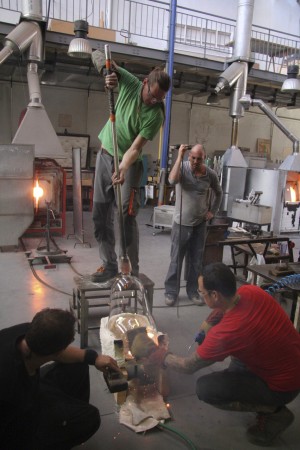 Today, an artist who wants to experiment with glass, a difficult material that requires special equipment and exceptional skills, would have difficulty doing so in his workshop without the appropriate furnaces and know-how. Glass, a material and a technique dating from thousands of years ago, is the subject of real mythology. For the “transmutation” of sand minerals into a transparent solid is easily regarded with an aura of mystery, and the furnace where it happens makes the master glassmaker appear to be a sort of alchemist. It is not by chance that Werner Herzog chose glasswork for his craft allegory of creation. And it was not by chance that the main characters in his film, Heart of Glass, acted under hypnosis. For glass fascinates the ordinary onlooker who watches glass-blowers completing the stages of the process with the assurance and grace of dancers, despite the difficulty of the actions, the heat of the furnace and the weight of the gathered material, increased by the leverage effect of the blow tube.
Today, an artist who wants to experiment with glass, a difficult material that requires special equipment and exceptional skills, would have difficulty doing so in his workshop without the appropriate furnaces and know-how. Glass, a material and a technique dating from thousands of years ago, is the subject of real mythology. For the “transmutation” of sand minerals into a transparent solid is easily regarded with an aura of mystery, and the furnace where it happens makes the master glassmaker appear to be a sort of alchemist. It is not by chance that Werner Herzog chose glasswork for his craft allegory of creation. And it was not by chance that the main characters in his film, Heart of Glass, acted under hypnosis. For glass fascinates the ordinary onlooker who watches glass-blowers completing the stages of the process with the assurance and grace of dancers, despite the difficulty of the actions, the heat of the furnace and the weight of the gathered material, increased by the leverage effect of the blow tube.
But contemporary artists are lucky. For thirty years, there has been a unique art centre in France, devoted to artistic experimentation and research concerning glass: CIRVA. It is also an opportunity for the observer of do-it-yourself work to examine the complex relationships between the artist, the material and the technician. If studying art from a do-it-yourself viewpoint has meaning, it is because, to understand the work, one must understand how it was produced and what technical processes acted on the material. This does not apply to all works of art, of course. But, in the case of the results of the CIRVA artists’ and designers’ residencies, the do-it-yourself viewpoint proves to be entirely relevant, since the artistic idea and the technical process are so intricately interlinked – sometimes to the surprise of the artists more than anyone.
Do you know Velazquez’s painting, The Forge of Vulcan? The one in which we see Apollo – wearing a crown of laurel, his head illuminated by the sun, and his milk-white skin glowing like that of a baby – who, with a majestic gesture, gives indications to the blacksmith god? The blacksmith looks at him with a rather puzzled expression. With his large badly-trimmed moustache, his torso bared like his assistants, busy working on a glowing red-hot piece of metal, he seems to be thinking: what on earth is this man saying?
This could be an allegory of CIRVA, in which Apollo represents the artist who comes for a residency and starts a project, innocently believing that he will revolutionize glass, and Vulcan and his assistants represent the members of the workshop staff who listen to him, while the furnaces heat up to 1,100° behind them, with the feeling that, once again, they will have to explain to the artist that it will not be quite so simple.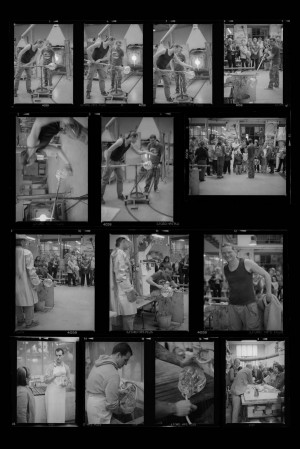 Imagine this other scene, which is real-life. An artist arrives at CIRVA. He is starting his residency, which will last for several months, or maybe several years in a series of intermittent stays. It is his first week. He does not know about glassmaking. Perhaps he has never made anything in glass. He has six pairs of eyes fixed on him: those of Isabelle the director, Christelle the staff coordinator, David the glass-blower in charge of the workshop, Fernando and Raphaël, the other two glass-blowers, and Roberto, who cold-works glass. They expect the artist to explain his project to them. But he discovers the enormous furnaces, which give off air so hot that it makes the lamps swing, hanging from the ceiling several metres above. He discovers the material and its different states: small white beads (pellets) at the beginning, then a soft red-hot mass when it is gathered in the furnace and handled with the blow tube, and finally a solid, transparent volume when it has cooled down. He especially discovers these characters, these masters of the art of glassmaking, who have given everything for their passion, who hold all the secrets of the technique, and who are nevertheless there, simple and modest, listening to his words, wishing to please him, ready to go with him on a journey to the unknown in this future project.
Imagine this other scene, which is real-life. An artist arrives at CIRVA. He is starting his residency, which will last for several months, or maybe several years in a series of intermittent stays. It is his first week. He does not know about glassmaking. Perhaps he has never made anything in glass. He has six pairs of eyes fixed on him: those of Isabelle the director, Christelle the staff coordinator, David the glass-blower in charge of the workshop, Fernando and Raphaël, the other two glass-blowers, and Roberto, who cold-works glass. They expect the artist to explain his project to them. But he discovers the enormous furnaces, which give off air so hot that it makes the lamps swing, hanging from the ceiling several metres above. He discovers the material and its different states: small white beads (pellets) at the beginning, then a soft red-hot mass when it is gathered in the furnace and handled with the blow tube, and finally a solid, transparent volume when it has cooled down. He especially discovers these characters, these masters of the art of glassmaking, who have given everything for their passion, who hold all the secrets of the technique, and who are nevertheless there, simple and modest, listening to his words, wishing to please him, ready to go with him on a journey to the unknown in this future project.
This is a great mystery: how can someone be both the king in their own kingdom and the first servant of an unknown person who comes into it, as long as the latter pronounces the magic phrase “I am an artist”? Let us leave Apollo for the moment. We know the artist well, too well. In an art centre, normally, one rolls out the red carpet for the artist. He is the one at the top end of the theoretical chain who makes the world of art live. Everyone depends on him – gallery owners, collectors, directors of art centres and museums, critics and exhibition curators. “There is no art, there are only artists”, wrote Ernst Gombrich at the beginning of his famous book, The Story of Art. 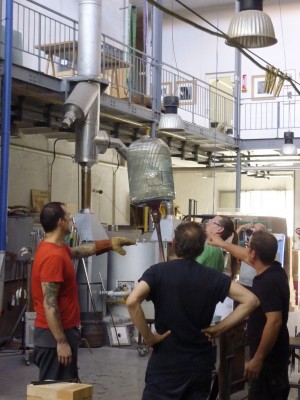 Indeed. This is not the occasion for removing the artist from the royal place that he occupies, nor for deconstructing his socio-theoretical character. Examining how things happen in CIRVA provides an opportunity for taking a different angle and concentrating on those of whom people never speak, yet who play an essential role: the technicians. Often (especially nowadays) an artist has one of his pieces made by specialist technicians. Usually, the former presents a project to the latter, they discuss it, the project is realised by them, and the piece is exhibited: the artist has the idea, and his name is on the title plaque; the technicians carry out the physical production or realisation of the project, and they are given a simple mention in the catalogue (if there is one).
Indeed. This is not the occasion for removing the artist from the royal place that he occupies, nor for deconstructing his socio-theoretical character. Examining how things happen in CIRVA provides an opportunity for taking a different angle and concentrating on those of whom people never speak, yet who play an essential role: the technicians. Often (especially nowadays) an artist has one of his pieces made by specialist technicians. Usually, the former presents a project to the latter, they discuss it, the project is realised by them, and the piece is exhibited: the artist has the idea, and his name is on the title plaque; the technicians carry out the physical production or realisation of the project, and they are given a simple mention in the catalogue (if there is one).
Things are different in CIRVA, in most cases. The principle of the prolonged residency established by the first director of this glass art centre, Françoise Guichon, and the extreme technicality combined with the very open mind of the technical staff tend to develop a more experimental type of creative work. Normally, the invited artists or designers are not chosen by Isabelle Reiher, the present director, for a specific project to be realised. They are chosen for their art and their personality in general. Therefore, when they come to CIRVA, they do not necessarily know in advance what is going to happen. They do not know what it is possible or impossible to make in glass; they do not know what can be done by the glass-blowers, who are capable of many things. Glass-blowers are driven by a will of Nietzschean power: throughout their lives, they have only one thing in mind: learning. Pushing back the boundaries of their know-how, of what it was possible for them to produce – the finest, the largest, the most complex pieces. They like to defy glass. To do so, they have virtually sacrificed their youth, going from school to school, from workshop to workshop, in France, in Europe, and throughout the world. 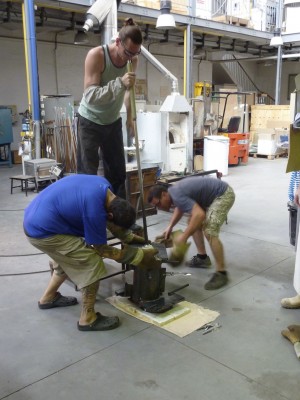 From the age of fourteen, Raphaël (who is now forty-two) started his apprenticeship in Vannes-le-Châtel, where a large part of his family worked in the CFC-Daum crystal glassworks. Then, with friends, and with the support of the mayor and the people of his village, while he worked in the glassworks, he took part as a teacher in the opening of a glassmaking school, which, in the 1990s, was to become France’s main training centre for glassmaking, CERFAV, where his CIRVA colleagues were all trained. A little later, he obtained a training scholarship and went away for four years to Paris and especially to Venice, where he attended three of Murano’s workshops, which are among the most reputed, with the highest standards. Lino Tagliapietra, the living god of glass-blowers, works in this temple of glass art with centuries of tradition behind it, where the workshops still function virtually as in Giotto’s time. The new arrival starts as a serventino who cleans the workshop and goes and gets materials. In some workshops, one does not have the right to look the maestro in the eyes; and, from the novice’s first steps in the workshop, he is capable of predicting the novice’s future in the world of glass. If the prediction is favourable, and if the novice proves himself and shows determination, then, like Raphaël, he may be allowed to assist the maestro himself.
From the age of fourteen, Raphaël (who is now forty-two) started his apprenticeship in Vannes-le-Châtel, where a large part of his family worked in the CFC-Daum crystal glassworks. Then, with friends, and with the support of the mayor and the people of his village, while he worked in the glassworks, he took part as a teacher in the opening of a glassmaking school, which, in the 1990s, was to become France’s main training centre for glassmaking, CERFAV, where his CIRVA colleagues were all trained. A little later, he obtained a training scholarship and went away for four years to Paris and especially to Venice, where he attended three of Murano’s workshops, which are among the most reputed, with the highest standards. Lino Tagliapietra, the living god of glass-blowers, works in this temple of glass art with centuries of tradition behind it, where the workshops still function virtually as in Giotto’s time. The new arrival starts as a serventino who cleans the workshop and goes and gets materials. In some workshops, one does not have the right to look the maestro in the eyes; and, from the novice’s first steps in the workshop, he is capable of predicting the novice’s future in the world of glass. If the prediction is favourable, and if the novice proves himself and shows determination, then, like Raphaël, he may be allowed to assist the maestro himself.
His colleagues have been to Murano like him. David (born in 1973), after a year’s foundation art course in Digne-les-Bains and two years in CERFAV, went from scholarship to scholarship and from workshop to workshop, in Denmark, Sweden, Germany, Montreal, the USA, and Murano, where he worked in ten different workshops. Also developing his own artistic sensibility and personal work, David “feels” the artists’ projects like no one else.
Fernando (born in 1976), an Argentinean, initially went to the glass school in Segovia, then to the school in Bolsano in Italy, where, for the first time, he met an artistic approach to glass, then to CERFAV and Murano. Like the others, he is always keen to perfect technique, which is different from one country to another and from one workshop to another. His dream was to go to Kenji Ito’s workshop in Japan. After several letters and several refusals, the Japanese glass-blower finally accepted him, but on two conditions that appeared impossible: that he must stay for at least a year, and that he must speak Japanese. But it was no problem for Fernando: he learned Japanese and went to Kenji Ito’s workshop in Japan, where he stayed for a year.
Roberto (born in 1977), who was initiated in glass in Barcelona, and who also attended CERFAV, specialised in cold-working and glass paste. At a very early stage, he opened a workshop near Montpellier where he sold his own pieces, then he entered the famous workshop near Rouen of the Leperliers, who were from a family of master glassmakers of whom an ancestor was a major figure of Art Nouveau.
As for Christelle (I will not mention her age, which is the same as mine), her background is different but no less interesting. She initially studied psychology in Strasbourg, but she was dissatisfied because of the lack of practical training. So she quickly turned to metal arts, thanks to a circle of artist friends who had a small forge and technical workshops. Then she put together a project in Marseille for occupational reintegration of schizophrenics, to whom she taught this difficult craft and forbade any procrastination and any hesitation. For four years, she combined psychiatric treatment and manual training, before applying for the position that she now holds. 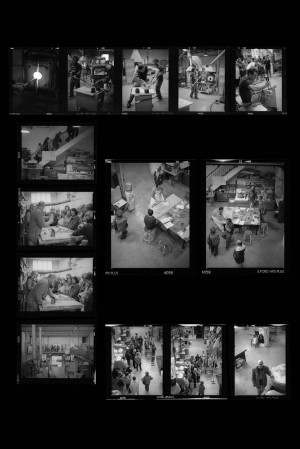 If these outstanding technicians are so modest, it is because, from the beginning, they have realized that there is always something new to be learned, a technique to be perfected or to be invented. If they like working in CIRVA, it is because artists encourage them to push back not only their own limits, but those of glasswork itself. It is not that artists, when they arrive freshly at 62 Rue de la Joliette, know how to make glass-blowers “unlearn their trade”, as some pretentious and ignorant people claim. It is quite the opposite that happens in the beginning: it is rare for an artist to propose an idea or a project right away that has not been already expressed and realized before. In reality, it is the artist and technicians together that make the project move forward. The artist learns about the material’s (numerous) constraints, but also its (immense) possibilities. While watching them working, the artist has “fifteen thousand ideas every second”, says Christelle. Some artists become integrated into the life of the workshop. They want to touch the material and to handle the blow tube – but nothing can replace ten years of experience. At the same time they make the workshop their own, and they give it a rhythm and a warmth that is personal for them. On the other hand, the technicians make the artist’s thinking their own, without deforming it. Fernando makes a nice musical comparison: the artist is the composer, and he is the performer. However, in music, the difference is that, if the musician plays a wrong note, he can always make up for it with the following note, whereas, in glass-blowing, it is impossible to make up for mistakes: everything has to be perfect from the moment when the glass is gathered in a furnace to the time when it is placed in another, less hot furnace, to allow it to cool. Glass does not forget anything.
If these outstanding technicians are so modest, it is because, from the beginning, they have realized that there is always something new to be learned, a technique to be perfected or to be invented. If they like working in CIRVA, it is because artists encourage them to push back not only their own limits, but those of glasswork itself. It is not that artists, when they arrive freshly at 62 Rue de la Joliette, know how to make glass-blowers “unlearn their trade”, as some pretentious and ignorant people claim. It is quite the opposite that happens in the beginning: it is rare for an artist to propose an idea or a project right away that has not been already expressed and realized before. In reality, it is the artist and technicians together that make the project move forward. The artist learns about the material’s (numerous) constraints, but also its (immense) possibilities. While watching them working, the artist has “fifteen thousand ideas every second”, says Christelle. Some artists become integrated into the life of the workshop. They want to touch the material and to handle the blow tube – but nothing can replace ten years of experience. At the same time they make the workshop their own, and they give it a rhythm and a warmth that is personal for them. On the other hand, the technicians make the artist’s thinking their own, without deforming it. Fernando makes a nice musical comparison: the artist is the composer, and he is the performer. However, in music, the difference is that, if the musician plays a wrong note, he can always make up for it with the following note, whereas, in glass-blowing, it is impossible to make up for mistakes: everything has to be perfect from the moment when the glass is gathered in a furnace to the time when it is placed in another, less hot furnace, to allow it to cool. Glass does not forget anything.
Sometimes, as Roberto says, the artist’s or designer’s project requires them to bend rules, to play against the material, against the technique: to give the glass the appearance of stone, to mix incompatible materials, to make volcanoes explode in the furnaces, and so on. In these cases, which are more difficult than others, the relationship between the artist and the technician must be excellent. The technician “gets into the artist’s brain”, says David, “and replaces his hands”. Hreinn Fridfinnsson the Icelander perfectly understood this. During his residency in CIRVA in 1994, seeing the technicians’ manual mastery, and admitting that he was incapable of doing anything with his own hands, he decided to take a mould of them and to cast a copy of them in glass, to give them to the staff, in brief, “so that they would serve some purpose”. The best pieces come out of this mutual giving of oneself, this synergy between the artist and the technicians. For, if the artist manages to get the glass-blowers to go further, to surpass themselves, to sweat blood while holding pieces weighing several tens of kilos with the strength of their arms, it is because he shows them respect and recognition. And if the glass-blowers accept the hard labour and the sometimes terrible efforts that the artists’ (sometimes pharaonic) projects require of them, it is because the artists transport them, with their energy, their generosity and their inventiveness.
The relationship between the artists and CIRVA’s technical staff members is unique. What can we call their occupation? They are not just craftsmen, because their work entails a greater degree of experimentation. They are not just art technicians, because, even if they have undeniable technical virtuosity, they are well aware that technique is only a means to an end, and that the end itself is something else. When I asked David to define his occupation, he gave me the answer which I think is the most correct: “CIRVA glass-blower”.
Thomas Golsenne
This text was written after interviews by the author in November 2012 and January 2013 with Christelle Notelet, Roberto Avila, David Veis, Raphaël Veloso and Fernando Torre. We are grateful to them for their help and their receptiveness.
Further reading:
Le CIRVA
Motifs – Thomas Golsenne’s blog
